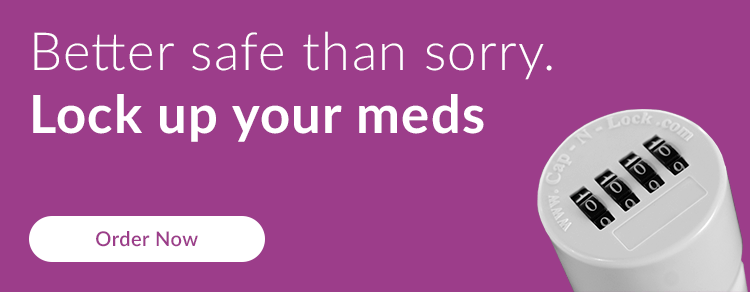Parents of teenagers seem to fall into one of two camps when it comes to their kid and drugs. On one hand, there is the parent who insists their teen has never, and would never, dream of experimenting. And on the other is the parent who feels helpless to stop what appears to be the inevitable oncoming storm of substance use disorder and resulting behaviors.
Whether you think your teen would never use drugs, or worry that your teen has already done them all, these are the real statistics about teenage substance abuse.
Half of All Teens are Trying Drugs
Parents, there is a 50% chance that your kid has tried drugs at least once.
By the time they’ve reached 12th grade, 46.6% of all teens have tried an illicit drug at least once. That means nearly one out of every two teens has experimented with a drug at least one time.
Secure your prescription painkillers at home with a Safer Lock Box.
Teens are Using Marijuana
Nearly half (43.7%) of U.S. teens have tried marijuana at least once, according to the National Center for Drug Abuse Statistics. It is one of the most commonly used substances among teens and college students, second only to alcohol.
Nearly one in three 12th graders has used marijuana in the past year, and 7% are using marijuana daily.
Teens are using marijuana for enjoyment and to cope or forget their problems, according to one study. “We know that earlier onset of cannabis use is associated with the likelihood of developing a cannabis use disorder,” said Nicole Shultz, study author and assistant professor in the UC Davis Department of Psychiatry and Behavioral Sciences.
What many teens may not realize is that marijuana use can have detrimental effects. New research is linking teen cannabis use to an increased risk of mental disorders, including a dramatically higher rate of developing a psychotic disorder.
Teens are Drinking
If your kid isn’t trying drugs, they might be drinking. Alcohol is the most commonly abused substance among teens and young adults.
A 2024 report from the World Health Organization (WHO) found that 57% of 15-year-olds surveyed had tried alcohol at least once and nearly 4 in 10 (37%) self-reported that they had consumed alcohol in the past 30 days.
- 62% of 12th grade teenagers have abused alcohol
- 20% of 15 year olds have reported “significant drunkness”
- 8.6% of young adults (aged 12-20) report binge drinking in the past month
Teens are Driving Under the Influence
Even though you’ve told your kids never to drink and drive, they’re not necessarily listening.
An estimated 12% of teens, and more than 25% of young adults ages 21-25, are driving a vehicle under the influence of alcohol at least once per year.
More than two-thirds of teens (68%) who admitted to driving under the influence of alcohol admit they have done so after having more than three alcoholic beverages.
Your teen doesn’t necessarily view riding in the car with a drinking driver as dangerous. A survey found that 30% of teens have knowingly accepted a ride from a driver who had been drinking in the past year.
Car crashes are the #1 cause of accidental death and injury for young people, and one third (32%) of all traffic-related deaths in the U.S. are a result of alcohol-impaired driving crashes.
Teens are E-Smoking
The good news is that teens are smoking cigarettes less than ever before. But that doesn’t mean they aren’t smoking. The WHO report found 32% of 15-year-olds had used e-cigarettes during their lifetime, and 20% had used e-cigarettes in the past 30 days.
10% of all high school students reportedly use tobacco products, according to the FDA, with e-cigarettes being the most popular tobacco product for ten years in a row. More than 2 million youth currently use e-cigarettes and more than 25% of them are using e-cigarettes daily.
E-cigarettes go by many names, including vapes, vape pens, e-cigs, mods, and tanks. The overall sales of e-cigarettes increased by 46% between 2020 and 2022, while the number of unique e-cigarette products available more than quadrupled in the same time frame.
The Facts of Teen Substance Use
Over half of 12th graders report trying an illicit drug, including cannabis, at least once. Illicit drug use is highest among the late teen and early twenties age group, with more than 23% of 18- to 25-year olds reporting illicit drug use within the past month.
Marijuana is the most commonly used substance for new illicit drug users.
The next most commonly used drugs are prescription pain relievers.
A Prescription for Abuse
Fifty-two million people over the age of 12 in the US have misused prescription drugs in their lifetime. According to the Center for Lawful Access and Abuse Deterrence (CLAAD), more than 25% of all people who started abusing drugs last year began with prescription medications such as pain relievers, tranquilizers, stimulants, and sedatives.
The top 4 reasons teens use prescription drugs include:
- Easy to get from parent’s medicine cabinets (62%)
- Available everywhere (52%)
- They are not illegal drugs (51%)
- Easy to get through other people’s prescriptions (50%)
Six out of ten teens who abuse prescription drugs get them free from friends and relatives. Your medicine cabinet could be an unwitting supplier to the teens that come in and out of your home.
Fentanyl is the Leading Cause of Teen Overdose Deaths
Teen overdose deaths are on the rise, doubling over a ten year span from 2010 to 2021. Behind 77% of these teen overdose deaths is fentanyl, a synthetic opioid that is found in counterfeit prescription opioids (painkillers) and benzodiazepines (anti-anxiety medications). Fentanyl is also added to other illicit drugs such as methamphetamines and cocaine.
Fentanyl is up to 50 times stronger than heroin and 100 times stronger than morphine. It is cheap to make and is often added to illicit drugs as a low-cost way to make them more potent and addictive.
It’s never been a more dangerous time for teens to experiment with illicit street drugs or counterfeit prescription pills. Two out of every five counterfeit opioid pills contain enough fentanyl to deliver a fatal overdose, and its nearly impossible to detect if fentanyl has been added to illicit drugs or counterfeit pills.
Teen Drug Use Can Lead to Tragedy
Unfortunately, drug experimentation can lead to tragic tales of teen addiction, overdose, and death.
Opioid-related overdose deaths increased steadily from 1999 to 2022. Drug overdose deaths from prescription opioids rose by 327% from 1999 to 2022.
Overdose deaths from stimulants, such as methamphetamines or cocaine, in combination with synthetic opioids such as fentanyl have increased by 374% over that same time period.
One-half of the nearly 4.6 million drug-related emergency room visits each year are due to adverse reactions from prescription pharmaceuticals, including drug misuse and abuse.
What Parents Can Do
Parents need to know that teenage drug use is a serious threat to their children. The younger a person begins experimenting with drugs, the greater the risk of becoming addicted.
The teen brain is hardwired for addiction, and teen drug use can cause serious changes to a teen’s brain.
The good news is that parents are not entirely powerless to help steer their teens away from drug misuse that can lead to abuse, addiction, or fatalities. Teens who learn about the risks of drugs from their parents are less likely to use drugs than those who don’t. Talking to your teen matters.
But you can go one step further to protect your teens from drugs, too. Alcohol, marijuana, and prescription drugs are the most commonly used substances for teens, and just happen to be the ones most likely to be found in your home.
Lock up all medications, including prescriptions, over-the-counter medications, or medical cannabis products. Try one of these 4-digit locking products:
- Safer Lock Box: a medication lock box ideal for securing multiple prescription medications
- Safer Lock: a combination locking cap that can secure one single prescription bottle
- Rx Locking Bag: a combination locking storage bag perfect for securing medications for travel
Keep medications and alcohol out of reach and out of sight of children, and keep track of how much you are using. Continue to talk to your kids about the dangers of drugs and alcohol.
Your efforts at home may be the key to preventing your teen from becoming one more sobering statistic about teenage drug use.




